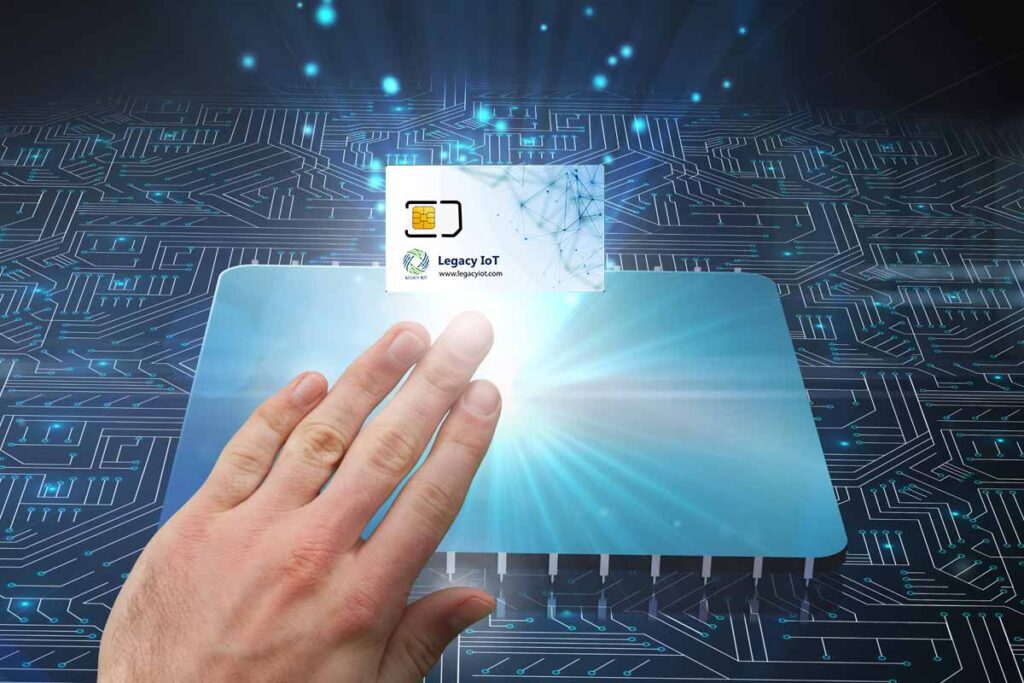What is an IoT SIM Card?
In today’s hyper-connected world, where devices are seamlessly integrated into our daily lives, the term “IoT SIM card” might sound like another piece of tech jargon. However, it plays a crucial role in enabling the communication between various devices, forming the backbone of the Internet of Things (IoT) ecosystem.

So, what exactly is an IoT SIM card, and how does it function in the realm of connected devices? Let’s discuss in a blog.
Introduction
In this digital era, where everything from our smartphones to our refrigerators is interconnected, the Internet of Things (IoT) has emerged as a transformative force. At the heart of this interconnected web lies the IoT SIM card, a tiny yet powerful component that facilitates communication between devices.
Purpose and Functionality
The primary function of IoT SIM cards is to provide reliable connectivity to IoT devices, enabling them to transmit data to and from the cloud. These cards are essential for applications such as remote monitoring, asset tracking, and smart city initiatives. One of the key benefits of IoT SIM cards (or eSim card) is their ability to function across various networks and geographical locations, ensuring uninterrupted connectivity for IoT deployments worldwide.
How Does an IoT SIM Card Work?
IoT SIM cards operate on cellular networks, allowing devices to transmit and receive data wirelessly. These cards are equipped with unique identifiers that enable them to establish secure connections with network towers, ensuring seamless communication between devices.
Benefits of IoT SIM Cards
1. Global Connectivity: IoT SIM cards offer worldwide coverage, allowing devices to stay connected regardless of their location.
2. Cost-Effectiveness: With flexible pricing plans and data packages, IoT SIM cards offer cost-effective solutions for IoT deployments.
3. Remote Management: IoT SIM cards can be remotely managed and provisioned, enabling easy activation and deactivation of devices.
4. Scalability: Whether you have ten devices or ten thousand, IoT SIM cards can scale to meet the demands of your IoT deployment.
IoT SIM Card vs Traditional SIM Card
While traditional SIM cards are designed for consumer smartphones, IoT SIM cards are optimized for machine-to-machine communication. They offer enhanced security features, lower power consumption, and greater durability, making them ideal for IoT applications. Want to know more about the difference between a m2m sim card and a normal sim card?
Technical Specifications
IoT SIM cards come in different sizes and form factors, ranging from traditional SIM cards to embedded modules. They are compatible with a wide range of IoT devices, including sensors, meters, and industrial machinery. Additionally, IoT SIM cards offer flexible data plans tailored to the specific needs of IoT applications, with options for low-power, low-data usage devices as well as high-bandwidth applications.
IoT SIM Card Providers
Several companies specialize in providing IoT SIM cards and related services to businesses and organizations deploying IoT solutions. Legacy IoT, an leading IoT service provider in India with esim or embedded sim card, m2m sim cards services including SIM card provisioning, data management platforms, and connectivity management solutions and more. Pricing models vary depending on factors such as data usage, network coverage, and additional services.
Challenges and Solutions
Despite their many benefits, IoT SIM cards face challenges such as connectivity issues and roaming concerns, particularly in remote or geographically diverse environments. However, Our IoT SIM card offers solutions such as multi-network connectivity and global roaming agreements to address these challenges and ensure seamless connectivity for IoT deployments.
Security Considerations
Security is a paramount concern in the world of IoT, and IoT SIM cards are no exception. Legacy IoT sim cards utilize advanced encryption protocols to secure data transmissions, protecting against unauthorized access and cyber threats.
The Future of IoT SIM Cards
Looking ahead, the future of IoT SIM cards is promising, with ongoing advancements in technology driving innovation in the IoT connectivity space. As 5G networks continue to roll out globally, IoT SIM cards are poised to leverage the higher bandwidth and lower latency offered by 5G technology, enabling new use cases and applications for IoT devices.
Conclusion
In conclusion, IoT SIM cards are the unsung heroes of the Internet of Things, enabling seamless communication between connected devices on a global scale. With their advanced features, security protocols, and scalability, IoT SIM cards are poised to play an increasingly pivotal role in shaping the future of IoT technology.
FAQs
Q1. What is the difference between a regular SIM card and an IoT SIM card?
A regular SIM card is designed for use in smartphones and traditional cellular devices, whereas an IoT SIM card is specifically tailored for IoT applications, offering features such as low-power consumption and global connectivity.
Q2. Can IoT SIM cards be used for personal smartphones?
No, IoT SIM cards are not intended for use in personal smartphones. They are optimized for IoT devices and may not be compatible with smartphones or consumer electronics.
Q3. How do IoT SIM cards ensure security in data transmission?
IoT SIM cards incorporate encryption and authentication mechanisms to secure data transmission between devices and the cloud, protecting against unauthorized access and cyber threats.
Q4. Are there any limitations to the coverage of IoT SIM cards?
While IoT SIM cards offer global coverage, there may be limitations in remote or geographically isolated areas where cellular networks are not available.
Q5. What industries benefit the most from using IoT SIM cards?
Industries such as manufacturing, transportation, healthcare, and agriculture benefit greatly from using IoT SIM cards to enable remote monitoring, asset tracking, and other IoT applications.





